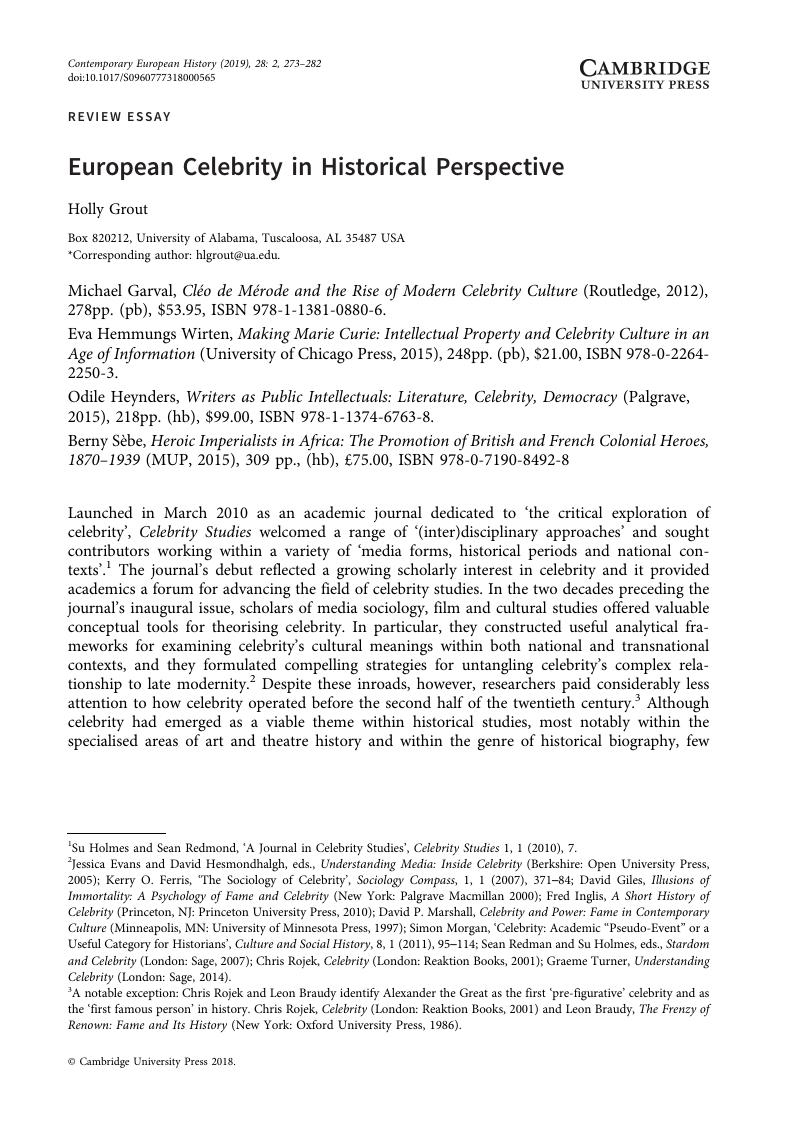Article contents
European Celebrity in Historical Perspective
Review products
Published online by Cambridge University Press: 23 October 2018
Abstract

- Type
- Review Essay
- Information
- Copyright
- © Cambridge University Press 2018
References
1 Holmes, Su and Redmond, Sean, ‘A Journal in Celebrity Studies’, Celebrity Studies 1, 1 (2010), 7 CrossRefGoogle Scholar .
2 Evans, Jessica and Hesmondhalgh, David, eds., Understanding Media: Inside Celebrity (Berkshire: Open University Press, 2005)Google Scholar ; Ferris, Kerry O., ‘The Sociology of Celebrity’, Sociology Compass, 1, 1 (2007), 371–384 CrossRefGoogle Scholar ; Giles, David, Illusions of Immortality: A Psychology of Fame and Celebrity (New York: Palgrave Macmillan 2000)CrossRefGoogle Scholar ; Inglis, Fred, A Short History of Celebrity (Princeton, NJ: Princeton University Press, 2010)CrossRefGoogle Scholar ; Marshall, David P., Celebrity and Power: Fame in Contemporary Culture (Minneapolis, MN: University of Minnesota Press, 1997)Google Scholar ; Morgan, Simon, ‘Celebrity: Academic “Pseudo-Event” or a Useful Category for Historians’, Culture and Social History, 8, 1 (2011), 95–114 CrossRefGoogle Scholar ; Redman, Sean and Holmes, Su, eds., Stardom and Celebrity (London: Sage, 2007)Google Scholar ; Rojek, Chris, Celebrity (London: Reaktion Books, 2001)Google Scholar ; Turner, Graeme, Understanding Celebrity (London: Sage, 2014)CrossRefGoogle Scholar .
3 A notable exception: Chris Rojek and Leon Braudy identify Alexander the Great as the first ‘pre-figurative’ celebrity and as the ‘first famous person’ in history. Rojek, Chris, Celebrity (London: Reaktion Books, 2001)Google Scholar and Braudy, Leon, The Frenzy of Renown: Fame and Its History (New York: Oxford University Press, 1986)Google Scholar .
4 Morgan, Simon, ‘Historicising Celebrity’, Celebrity Studies, 1, 3 (Nov. 2010), 366 CrossRefGoogle Scholar . Some recent celebrity biographies include: Cunningham, Hugh, Grace Darling: Victorian Heroine (London: Bloomsbury, 2007)Google Scholar ; Oliver Hilmes, trans. Spencer, Stewart, Franz Liszt: Musician, Celebrity, Superstar (New Haven: Yale University Press, 2016)Google Scholar ; Looseley, David, Edith Piaf: A Cultural History (Liverpool: University of Liverpool Press, 2015)CrossRefGoogle Scholar ; McWilliam, Rohan, The Tichborne Claimant: A Victorian Sensation (London: Continuum Books 2007)Google Scholar ; Smith, Judith E., Becoming Belafonte: Black Artist, Public Radical (Austin, Texas: University of Texas Press, 2014)Google Scholar ; Kasson, John F., The Little Girl Who Fought the Great Depression: Shirley Temple and 1930s America (New York: W.W. Norton, 2014)Google Scholar ; Riall, Lucy, Garibaldi: Invention of a Hero (New Haven: Yale University Press, 2008)Google Scholar . Notable exceptions to the claim above include: Berenson, Edward and Giloi, Eva, eds., Constructing Charisma: Celebrity, Fame, and Power in Nineteenth-Century Europe (New York: Berghahn Books, 2010)Google Scholar ; Hindson, Catherine, London’s West End Actresses and the Origins of Celebrity Charity, 1880–1920 (Iowa City: University of Iowa Press, 2016)CrossRefGoogle Scholar ; Lilti, Antoine, The Invention of Celebrity: 1750–1850 (Cambridge: Polity Books, 2017)Google Scholar .
5 Morgan, Simon, ‘Historicising Celebrity’, Celebrity Studies, 1, 3 (Nov. 2010), 367 Google Scholar .
6 Ibid., 367.
7 Simon Morgan, ‘Celebrity: Academic “Pseudo-Event”’, 95–7.
8 Ibid., 95, 98.
9 Ibid., 109–10.
10 Ibid., 98.
11 Braudy, The Frenzy of Renown; Berenson and Giloi, eds., Constructing Charisma, 6–7; Evans and Hesmondhalgh, eds., Understanding Media, 4.
12 Holmes and Redmond, ‘A Journal in Celebrity Studies’, 2, 4, and 11; Richard Dyer cited in Sean Redmond and Su Holmes, eds., Stardom and Celebrity, 87. Berenson argues that whereas charisma relies upon an emotional bond between the individual and the audience, fame merely requires that the individual be an object of discussion among an audience with whom s/he may or may not cultivate a connection. Berenson and Giloi, eds., Constructing Charisma, 6.
13 Edward Berenson, ‘Charisma and the Making of Imperial Heroes in Britain and France, 1880–1914’, in Berenson and Giloi, eds., Constructing Charisma, 21–40.
14 Berenson, ‘Charisma and the Making of Imperial Heroes’, 40.
15 Evans and Hesmondhalgh, eds., Understanding Media, 2; Redmond and Holmes eds., Stardom and Celebrity, 309.
16 Edward Berenson and Eva Giloi eds., Constructing Charisma, 17.
17 Ibid., 2; Redmond and Holmes eds., Stardom and Celebrity, 310; Gaffney, John and Holmes, Diana eds., Stardom in Postwar France (NY: Berghahn Books, 2007), 8 Google Scholar .
18 Morgan, ‘Historicising Celebrity’, 366.
19 Evans and Hesmondhalgh highlight the contours of this debate through Daniel Boorstin’s Frankfurt school inspired theory of celebrity as pseudo-event in The Image: A Guide to Pseudo-Events in America, 1961 and Richard Dyer’s reception focus approach in Stars, 1979 and Heavenly Bodies, 1986. Evans and David Hesmondhalgh, eds., Understanding Media, 6.
20 To this end, Curie worked with fan turned de facto publicist Missy Brown Meloney to undertake a paid publicity tour of the United States; she accepted a gram of radium from admirers for her lab; she became the first honorary member of a female chemistry sorority at the University of Chicago, and she signed copies of Pierre Curie for fundraisers.
21 Redmond and Holmes eds., Stardom and Celebrity, 257; Holmes and Redmond, ‘A Journal in Celebrity Studies’, 4, 7.
22 Gaffney and Holmes eds., Stardom in Postwar France, 1.
23 Dyer argues that celebrities enable ‘access political matters of class, gender, race, and sexuality that underline the dominant ideology of that society at the time’. Dyer cited in Redmond and Holmes eds., Stardom and Celebrity, 258.
24 Berenson makes this same point: ‘even when the trails heroes blaze are too difficult for others to follow, charismatic figures nonetheless open up new possibilities. They do so by demonstrating what can be done and allowing large numbers of people to associate themselves, however indirectly and vicariously, with what they have achieved’. Berenson, ‘Charisma and the Making of Imperial Heroes’, 24.
- 1
- Cited by




